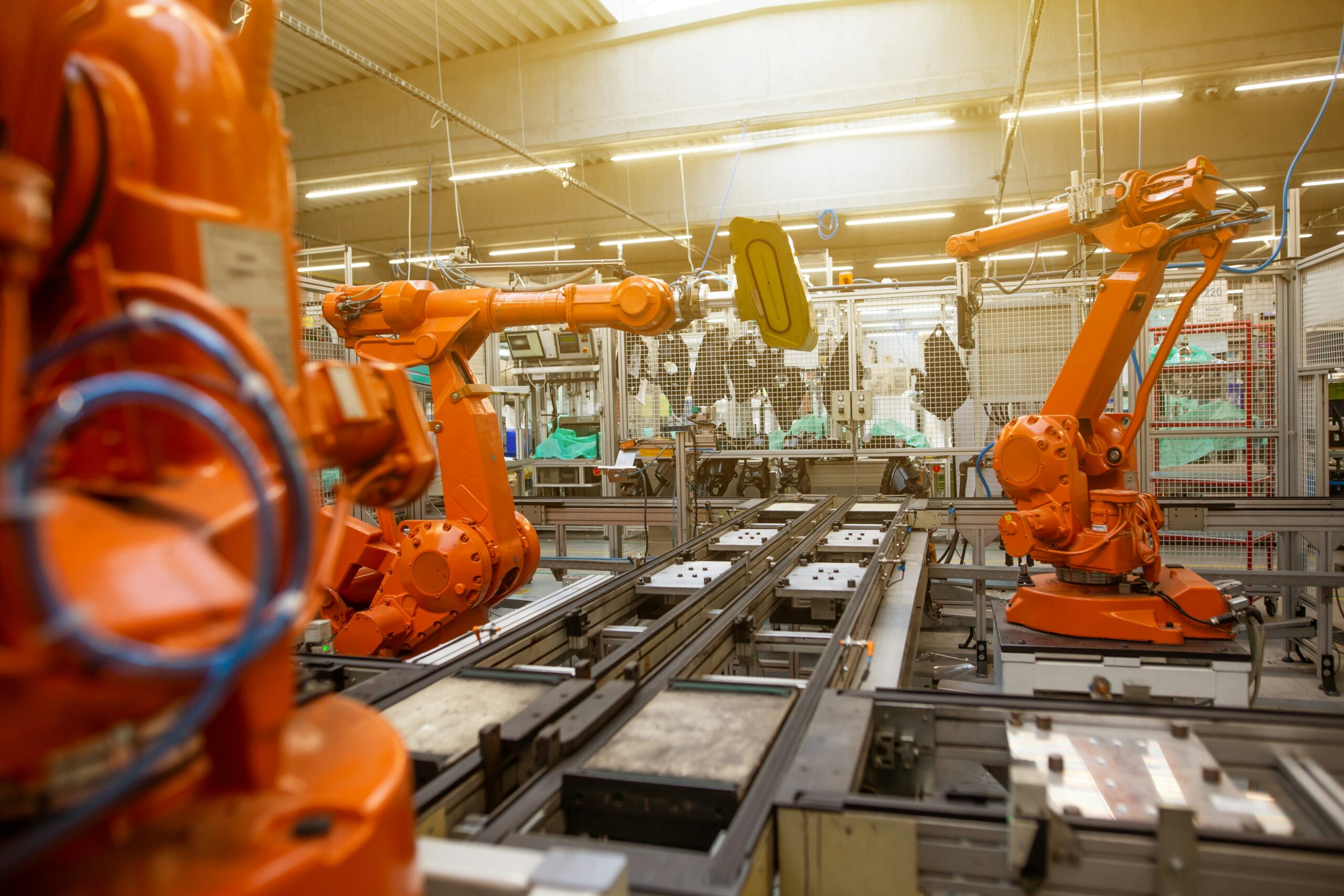The Factory Of The Future
We are experiencing an industrial revolution, and it isn’t talked about and celebrated as much as it should be. Manufacturing landscapes are undergoing an amazing transformation. In other words, we stand on the cusp of a new industrial era, where technology intertwines seamlessly with production processes. For instance, smart factories leverage IoT and AI to optimise operations, marking a departure from traditional manufacturing practices. In addition, this technological evolution isn’t merely about efficiency; it’s about redefining the very essence of production.
Furthermore, in the light of Industry 4.0, the Factory of the Future integrates robotics and automation. As a matter of fact, these technological advancements not only streamline production but also open avenues for customisation and flexibility. Similarly, the evolution of digital twins and predictive maintenance stands as a testament to the marked changes in the manufacturing landscape. Altogether, this transformative journey isn’t just a progression; it’s a revolution that shapes the future of industry.
What Is The Factory Of The Future?
The Factory of the Future stands at the forefront of a manufacturing revolution. In other words, we’re witnessing a seismic shift. Without a doubt, Industry 4.0 brings forth a new era where technology converges with production in unprecedented ways. As a matter of fact, the traditional assembly lines are evolving into dynamic ecosystems fuelled by innovation. This evolution isn’t merely about automation; it’s a comprehensive reimagining of how products are conceived, created, and delivered.
In the light of Industry 4.0, the Factory of the Future embraces interconnected systems, where IoT and AI coalesce. For instance, smart factories utilise real-time data to optimize processes, marking a departure from conventional manufacturing practices. In addition, the integration of robotics and automation, as well as the advent of digital twins, signify a paradigm shift. Altogether, this transformative journey is not just about adopting newer technologies; it’s about fundamentally altering the DNA of manufacturing itself.
Key Technologies Shaping The Future
Key technologies are steering the Factory of the Future into uncharted territories. As a matter of fact, IoT and AI are pivotal. In other words, smart factories leverage these technologies to revolutionize manufacturing processes. Real-time data analytics, for instance, optimizes operations, enhancing efficiency and adaptability. This transformative integration not only streamlines production but also opens avenues for customisation and flexibility.
In addition, Industry 4.0 brings forth the integration of robotics and automation. Without a doubt, this marks a shift towards more agile and flexible production. Digital twins, another revolutionary technology, replicate physical systems in a virtual environment. For instance, this enables predictive maintenance, reducing downtime and ensuring continuous production. Furthermore, digital twins foster innovation by allowing manufacturers to simulate and test various scenarios before implementing changes in the physical environment.
Altogether, the synergy between these technologies is reshaping manufacturing landscapes. The Factory of the Future is not just automated; it’s a dynamic, interconnected ecosystem, markedly different from traditional assembly lines. Moreover, as we embrace these advancements, human-machine collaboration becomes paramount. At this stage, what is often called the fourth industrial revolution will shift to the fifth. For instance, on one hand, AI and automation enhance efficiency; on the other hand, human creativity and adaptability remain irreplaceable. In that case, the Factory of the Future is not about replacing humans but empowering them alongside advanced technologies for a more resilient and innovative industrial landscape.
Customisation and Flexibility
Customization and flexibility define the Factory of the Future, ushering in a new era in manufacturing. In other words, traditional mass production is giving way to tailored and adaptable production processes. As a matter of fact, industries can now swiftly adapt to changing demands and market trends.
For instance, the integration of digital technologies enables the production of personalized products with remarkable efficiency. Furthermore, in that case, the Factory of the Future emphasizes on-demand manufacturing, reducing excess inventory and minimising waste. On one hand, this approach aligns with sustainability goals; on the other hand, it enhances cost-effectiveness.
However, it’s important to acknowledge that although automation plays a crucial role, human input is equally indispensable. Still, human workers bring creativity, problem-solving skills, and adaptability that machines, however advanced, cannot replicate. In that case, the Factory of the Future envisions a harmonious collaboration between human expertise and technological innovation for unparalleled manufacturing capabilities.
Global Implications and Adoption
The global adoption of the Factory of the Future is marked by remarkable implications for manufacturing industries worldwide. As a matter of fact, the impact is evident across diverse sectors, from automotive to electronics. For instance, companies are investing substantially in upgrading their manufacturing facilities, with the market for industrial automation potentially reaching $250 billion by 2035.
In that case, the shift towards automated, interconnected systems not only enhances efficiency but also contributes to economic growth. On one hand, this evolution is welcomed for its potential to create high-tech job opportunities. On the other hand, challenges arise in terms of workforce transition and the need for upskilling.
However, the adoption of the Factory of the Future isn’t uniform worldwide. Although developed nations are markedly progressing, emerging economies are still catching up. Regardless of geographical location, the transition brings about increased competitiveness and productivity. In other words, the Factory of the Future has become a global endeavor, shaping the future of manufacturing on a worldwide scale.
Benefits and Challenges
The Factory of the Future brings about a myriad of benefits, markedly transforming the landscape of manufacturing. For instance, increased efficiency is a hallmark, as automation streamlines production processes. In addition, predictive maintenance reduces downtime, enhancing overall productivity and cost-effectiveness.
On one hand, customisation and flexibility empower industries to meet diverse market demands seamlessly. On the other hand, the integration of digital technologies necessitates workforce upskilling. However, this challenge presents an opportunity for human workers to thrive in more innovative and rewarding roles.
Nevertheless, the benefits of the Factory of the Future are not without their challenges. Although automation improves efficiency, it may raise concerns about potential job displacement. Updating facilities with complex machinery is costly and needs to warrant the investment. Still, with responsible implementation, these technologies can coexist harmoniously, creating a dynamic and resilient industrial future.
Future Trends and Innovations
The trajectory of the Factory of the Future points towards exciting trends and continual innovations. As a matter of fact, digitalization and connectivity will further revolutionise manufacturing processes. For instance, the rise of edge computing will bring real-time decision-making to the production floor.
In addition, the development of more sophisticated AI algorithms will lead to enhanced predictive maintenance and increased automation. Regardless of the industry, the integration of Augmented Reality (AR) and Virtual Reality (VR) will provide immersive experiences for training and troubleshooting.
However, challenges like cybersecurity risks and ethical considerations should not be overlooked. Still, the evolution toward a more sustainable and environmentally-friendly Factory of the Future is on the horizon. In that case, industries should adapt, aligning with the principles of responsible innovation. The future promises not only increased efficiency but also a manufacturing landscape that prioritizes sustainability and human well-being.
Final Thoughts
What we are calling the Factory of the Future is part of an industrial revolution, marked by efficiency, innovation, and adaptability. For instance, automation and connectivity are transforming manufacturing landscapes. In addition, the integration of AI, IoT, and other technologies paves the way for a more dynamic and interconnected future.
On one hand, the benefits are undeniable – increased productivity, reduced downtime, and the ability to meet diverse market demands. On the other hand, challenges such as workforce upskilling, cost and ethical considerations must be addressed. However, in that case, responsible implementation and a harmonious collaboration between humans and machines will define the success of this transformative journey.
In the light of global implications, industries worldwide are adapting to the Factory of the Future. As a matter of fact, this isn’t just a technological shift; it’s a paradigm change in how we conceive, create, and deliver products. Altogether, the future of manufacturing lies in embracing this revolution, ensuring that innovation goes hand in hand with sustainability and the well-being of both industries and the workforce.
Sources And Further Reading:
Forbes, “The Future Of Manufacturing: Generative AI And Beyond”
Deloitte, “Accelerating Sustainable Development in the 4th Industrial Revolution”
World Economic Forum, “The future of manufacturing: insights from industry leaders on navigating the Fourth Industrial Revolution”
CEO Magazine, “How the fifth industrial revolution will impact the future of work”
Written with Support from ChatGPT by OpenAI

